Paper Menu >>
Journal Menu >>
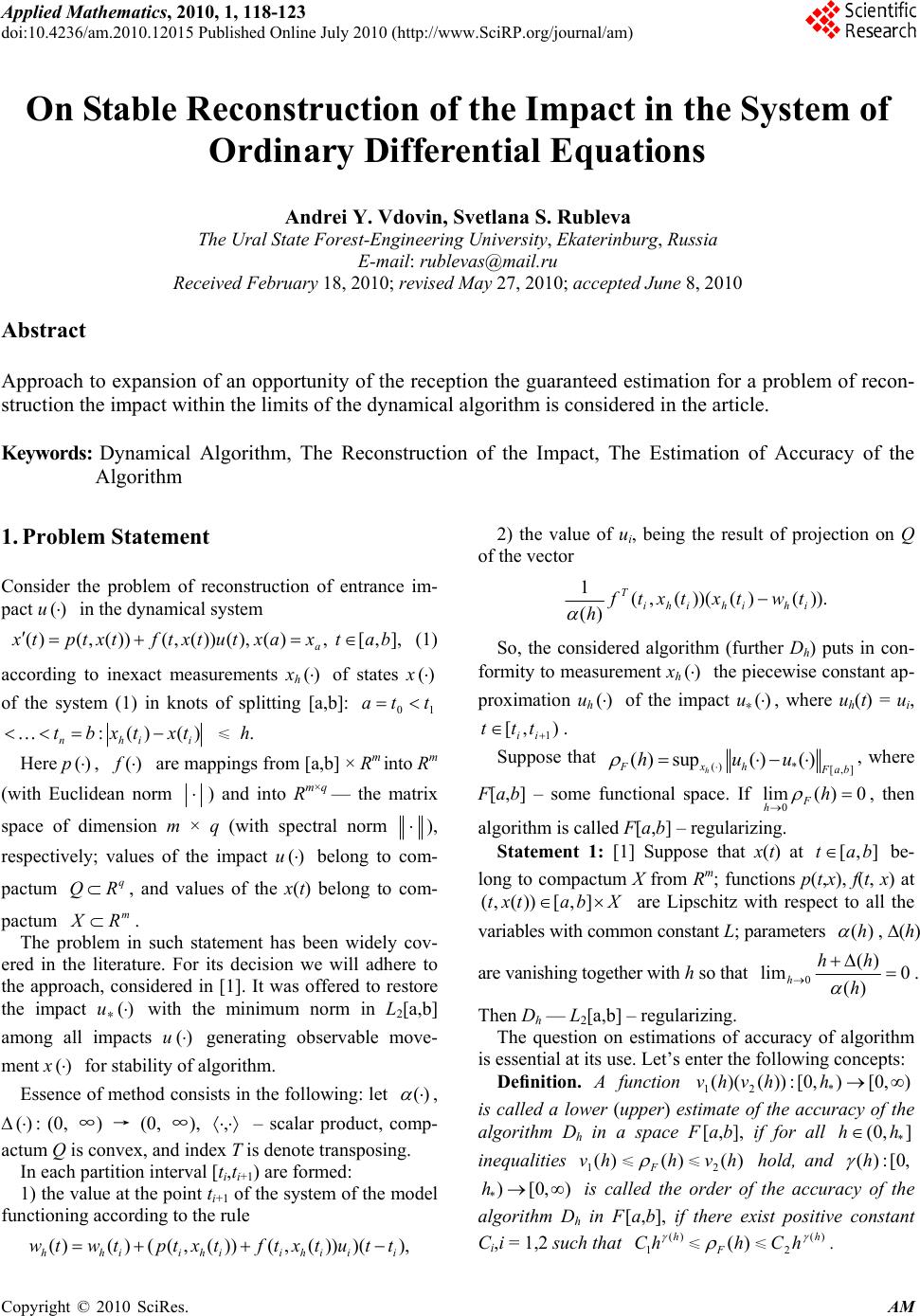 Applied Mathematics, 2010, 1, 118-123 doi:10.4236/am.2010.12015 Published Online July 2010 (http://www.SciRP.org/journal/am) Copyright © 2010 SciRes. AM On Stable Reconstruction of the Impact in the System of Ordinary Differential Equations Andrei Y. Vdovin, Svetlana S. Rubleva The Ural State Forest-Engineering University, Ekaterinburg, Russia E-mail: rublevas@mail.ru Received February 18, 2010; revised May 27, 2010; accepted June 8, 2010 Abstract Approach to expansion of an opportunity of the reception the guaranteed estimation for a problem of recon- struction the impact within the limits of the dynamical algorithm is considered in the article. Keywords: Dynamical Algorithm, The Reconstruction of the Impact, The Estimation of Accuracy of the Algorithm 1. Problem Statement Consider the problem of reconstruction of entrance im- pact u)( in the dynamical system ],,[,)(),())(,())(,()( bat xax tutxtftxtptxa (1) according to inexact measurements xh)( of states x)( of the system (1) in knots of splitting [a,b]: 10 tta )()(:iihn txtxbt ≤ h. Here p)(, )(f are mappings from [a,b] × Rm into Rm (with Euclidean norm ) and into Rm×q — the matrix space of dimension m × q (with spectral norm ), respectively; values of the impact u)( belong to com- pactum q RQ, and values of the x(t) belong to com- pactum m R X . The problem in such statement has been widely cov- ered in the literature. For its decision we will adhere to the approach, considered in [1]. It was offered to restore the impact u∗)( with the minimum norm in L2[a,b] among all impacts u)( generating observable move- ment x)( for stability of algorithm. Essence of method consists in the following: let )( , ∆)(: (0, ∞) → (0, ∞), , – scalar product, comp- actum Q is convex, and index T is denote transposing. In each partition interval [ti,ti+1) are formed: 1) the value at the point ti+1 of the system of the model functioning according to the rule ),)())(,())(,(()()( iiihiihiihhttutxtftxtptwtw 2) the value of ui, being the result of projection on Q of the vector )).()())((,( )( 1 ihihihi Ttwtxtxtf h So, the considered algorithm (further Dh) puts in con- formity to measurement xh)( the piecewise constant ap- proximation uh)( of the impact u∗)(, where uh(t) = ui, ),[ 1 ii ttt . Suppose that ()* [,] () sup()() h Fxh F ab huu , where F[a,b] – some functional space. If 0)(lim 0 h F h , then algorithm is called F[a,b] – regularizing. Statement 1: [1] Suppose that x(t) at ],[ bat be- long to compactum X from Rm; functions p(t,x), f(t, x) at Xbatxt ],[))(,( are Lipschitz with respect to all the variables with common constant L; parameters )(h , ∆(h) are vanishing together with h so that 0 )( )( lim 0 h hh h . Then Dh — L2[a,b] – regularizing. The question on estimations of accuracy of algorithm is essential at its use. Let’s enter the following concepts: Definition. A function ),0[),0[:))()((*21 hhvhv is called a lower (upper) estimate of the accuracy of the algorithm Dh in a space F [a,b], if for all ],0( * hh inequalities )( 1hv ≤)(h F ≤)( 2hv hold, and ,0[:)(h ),0[) * h is called the order of the accuracy of the algorithm Dh in F [a,b], if there exist positive constant Ci,i = 1,2 such that )( 1 h hC ≤)(h F ≤)( 2 h hC . 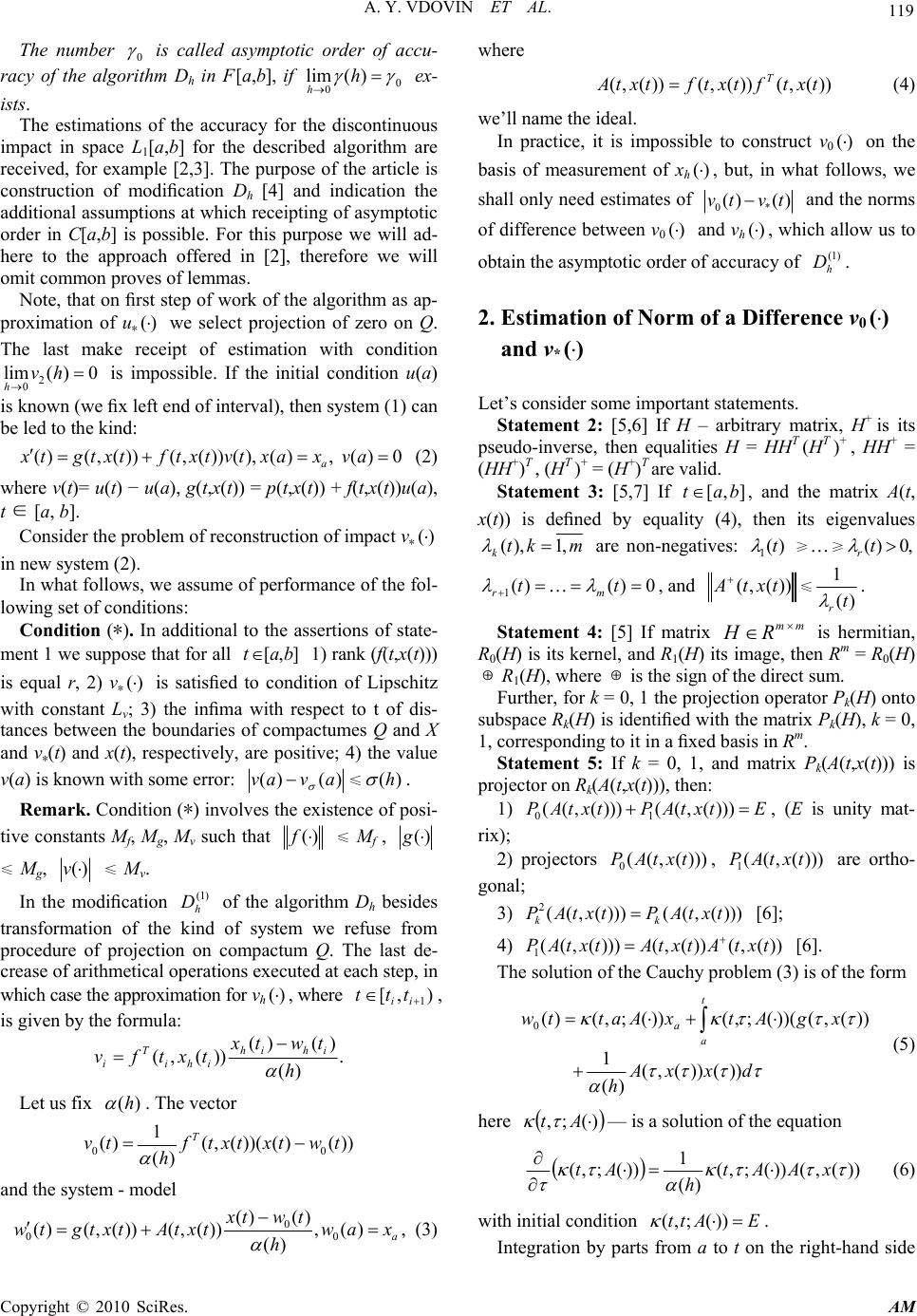 A. Y. VDOVIN ET AL. Copyright © 2010 SciRes. AM 119 The number 0 is called asymptotic order of accu- racy of the algorithm Dh in F [a,b], if 0 0)(lim h h ex- ists. The estimations of the accuracy for the discontinuous impact in space L1[a,b] for the described algorithm are received, for example [2,3]. The purpose of the article is construction of modification Dh [4] and indication the additional assumptions at which receipting of asymptotic order in C[a,b] is possible. For this purpose we will ad- here to the approach offered in [2], therefore we will omit common proves of lemmas. Note, that on first step of work of the algorithm as ap- proximation of u∗)( we select projection of zero on Q. The last make receipt of estimation with condition 0)(lim 2 0 hv h is impossible. If the initial condition u(a) is known (we fix left end of interval), then system (1) can be led to the kind: 0)(,)(),())(,())(,()( av xax tvtxtftxtgtxa (2) where v(t)= u(t) − u(a), g(t,x(t)) = p(t,x(t)) + f(t,x(t))u(a), t ∈ [a, b]. Consider the problem of reconstruction of impact v∗)( in new system (2). In what follows, we assume of performance of the fol- lowing set of conditions: Condition (*). In additional to the assertions of state- ment 1 we suppose that for all ],[bat 1) rank (f(t,x(t))) is equal r, 2) v∗)( is satisfied to condition of Lipschitz with constant Lv; 3) the infima with respect to t of dis- tances between the boundaries of compactumes Q and X and v∗(t) and x(t), respectively, are positive; 4) the value v(a) is known with some error: )()(avav ≤)(h . Remark. Condition (∗) involves the existence of posi- tive constants Mf, Mg, Mv such that )(f ≤ Mf , )(g ≤ Mg, )(v ≤ Mv. In the modification )1( h D of the algorithm Dh besides transformation of the kind of system we refuse from procedure of projection on compactum Q. The last de- crease of arithmetical operations executed at each step, in which case the approximation for vh)(, where ),[ 1 ii ttt , is given by the formula: . )( )()( ))(,(h t w t x txtfv ihih ihi T i Let us fix )( h . The vector ))()())((,( )( 1 )( 00 twtxtxtf h tv T and the system - model a xaw h twtx txtAtxtgtw )(, )( )()( ))(,())(,()( 0 0 0 , (3) where ))(,())(,())(,( txtftxtftxtA T (4) we’ll name the ideal. In practice, it is impossible to construct v0)( on the basis of measurement of xh)(, but, in what follows, we shall only need estimates of 0* () ()vt vt and the norms of difference between v0)( and vh)(, which allow us to obtain the asymptotic order of accuracy of )1( h D. 2. Estimation of Norm of a Difference v0)( and v*)( Let’s consider some important statements. Statement 2: [5,6] If H – arbitrary matrix, H+ is its pseudo-inverse, then equalities H = HHT (HT )+ , HH+ = (HH+)T , (HT )+ = (H+)T are valid. Statement 3: [5,7] If ],[ bat , and the matrix A(t, x(t)) is defined by equality (4), then its eigenvalues mkt k,1),( are non-negatives: )( 1t ≥≥,0)( t r 0)()( 1 tt mr , and ))(,( txtA≤ )( 1 t r . Statement 4: [5] If matrix mm HR is hermitian, R0(H) is its kernel, and R1(H) its image, then Rm = R0(H) ⊕ R1(H), where ⊕ is the sign of the direct sum. Further, for k = 0, 1 the projection operator Pk(H) onto subspace Rk(H) is identified with the matrix Pk(H), k = 0, 1, corresponding to it in a fixed basis in Rm. Statement 5: If k = 0, 1, and matrix Pk(A(t,x(t))) is projector on Rk(A(t,x(t))), then: 1) EtxtAPtxtAP )))(,(()))(,(( 10 , (E is unity mat- rix); 2) projectors )))(,(( 0txtAP, )))(,(( 1txtAP are ortho- gonal; 3) )))(,(()))(,(( 2txtAPtxtAP kk [6]; 4) ))(,())(,()))(,(( 1txtAtxtAtxtAP [6]. The solution of the Cauchy problem (3) is of the form dxxA h xgAtxAattw t a a ))())(,( )( 1 ))(,())((;,())(;,()( 0 (5) here )(;, At — is a solution of the equation ))(,())(;,( )( 1 ))(;,( xAAt h At (6) with initial condition EAtt ))(;,( . Integration by parts from a to t on the right-hand side 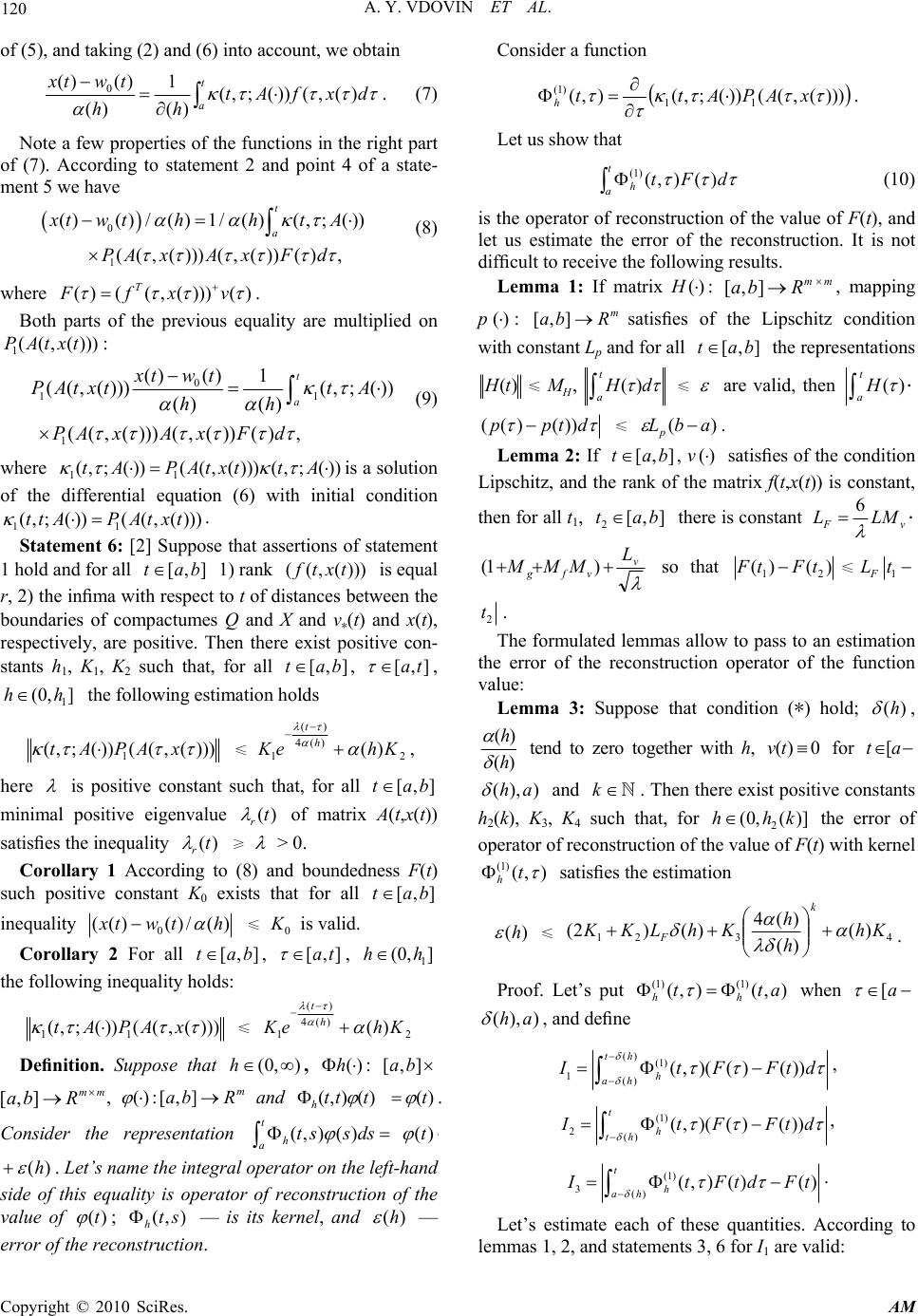 A. Y. VDOVIN ET AL. Copyright © 2010 SciRes. AM 120 of (5), and taking (2) and (6) into account, we obtain dxfAt hh twtx t a)(,())(;,( )( 1 )( )()(0 . (7) Note a few properties of the functions in the right part of (7). According to statement 2 and point 4 of a state- ment 5 we have 0 1 ()() /( )1/()(,;()) ((,()))(,())(), t a x twthhtA PA xA xFd (8) where )()))(,(()( vxfF T . Both parts of the previous equality are multiplied on )))(,(( 1txtAP : 0 11 1 ()() 1 ((,()))(,;()) () () ((,()))(,())(), t a x twt P At xttA hh PA xA xFd (9) where ))(;,()))(,(())(;,( 11 AttxtAPAt is a solution of the differential equation (6) with initial condition 11 (,;( ))((,()))ttAPAtxt . Statement 6: [2] Suppose that assertions of statement 1 hold and for all ],[ bat 1) rank )))(,(( txtf is equal r, 2) the infima with respect to t of distances between the boundaries of compactumes Q and X and v∗(t) and x(t), respectively, are positive. Then there exist positive con- stants h1, K1, K2 such that, for all ],[ bat , ],[ta , ],0( 1 hh the following estimation holds )))(,(())(;,( 1 xAPAt ≤ 2 )(4 )( 1)( KheK h t , here is positive constant such that, for all ],[ bat minimal positive eigenvalue )(t r of matrix A(t,x(t)) satisfies the inequality )(t r ≥ > 0. Corollary 1 According to (8) and boundedness F(t) such positive constant K0 exists that for all ],[ bat inequality )(/)()(( 0htwtx ≤ 0 K is valid. Corollary 2 For all ],[ bat , ],[ta , ],0( 1 hh the following inequality holds: )))(,(())(;,( 11 xAPAt ≤ 2 )(4 )( 1)( KheK h t Definition. Suppose that ),0( h, )(h: ],[ ba [,]mm abR , m Rba ],[:)( and )(),( ttt h )(t . Consider the representation t ahdssst )(),( )(t )( h . Let’s name the integral operator on the left-hand side of this equality is operator of reconstruction of the value of )(t ; ),(st h — is its kernel, and )( h — error of the reconstruction. Consider a function )))(,(())(;,(),( 11 )1( xAPAtt h . Let us show that t ahdFt )(),( )1( (10) is the operator of reconstruction of the value of F(t), and let us estimate the error of the reconstruction. It is not difficult to receive the following results. Lemma 1: If matrix H)(: [,]mm abR , mapping p)( : m Rba ],[ satisfies of the Lipschitz condition with constant Lp and for all ],[ bat the representations )(tH ≤ H M, () t a H d ≤ are valid, then ( ) t a H dtpp ))()(( ≤ )( abLp . Lemma 2: If ],[ bat , v)( satisfies of the condition Lipschitz, and the rank of the matrix f(t,x(t)) is constant, then for all t1, ],[ 2bat there is constant vFLML 6 v vfg L MMM )1( so that )()( 21 tFtF ≤1F Lt 2 t. The formulated lemmas allow to pass to an estimation the error of the reconstruction operator of the function value: Lemma 3: Suppose that condition (∗) hold; )(h , )( )( h h tend to zero together with h, 0)(tv for at [ )),(ah and k . Then there exist positive constants h2(k), K3, K4 such that, for )](,0( 2khh the error of operator of reconstruction of the value of F(t) with kernel ),( )1( t h satisfies the estimation )(h ≤ 4321 )( )( )(4 )()2( Kh h h KhLKK k F . Proof. Let’s put ),(),( )1()1(att hh when a[ )),(ah , and define () (1) 1() (,)(( )()) th h ah I tF Ftd , (1) 2()(,)(( )()) t h th I tF Ftd , (1) 3()(, )()() t h ah I tFtdFt . Let’s estimate each of these quantities. According to lemmas 1, 2, and statements 3, 6 for I1 are valid: 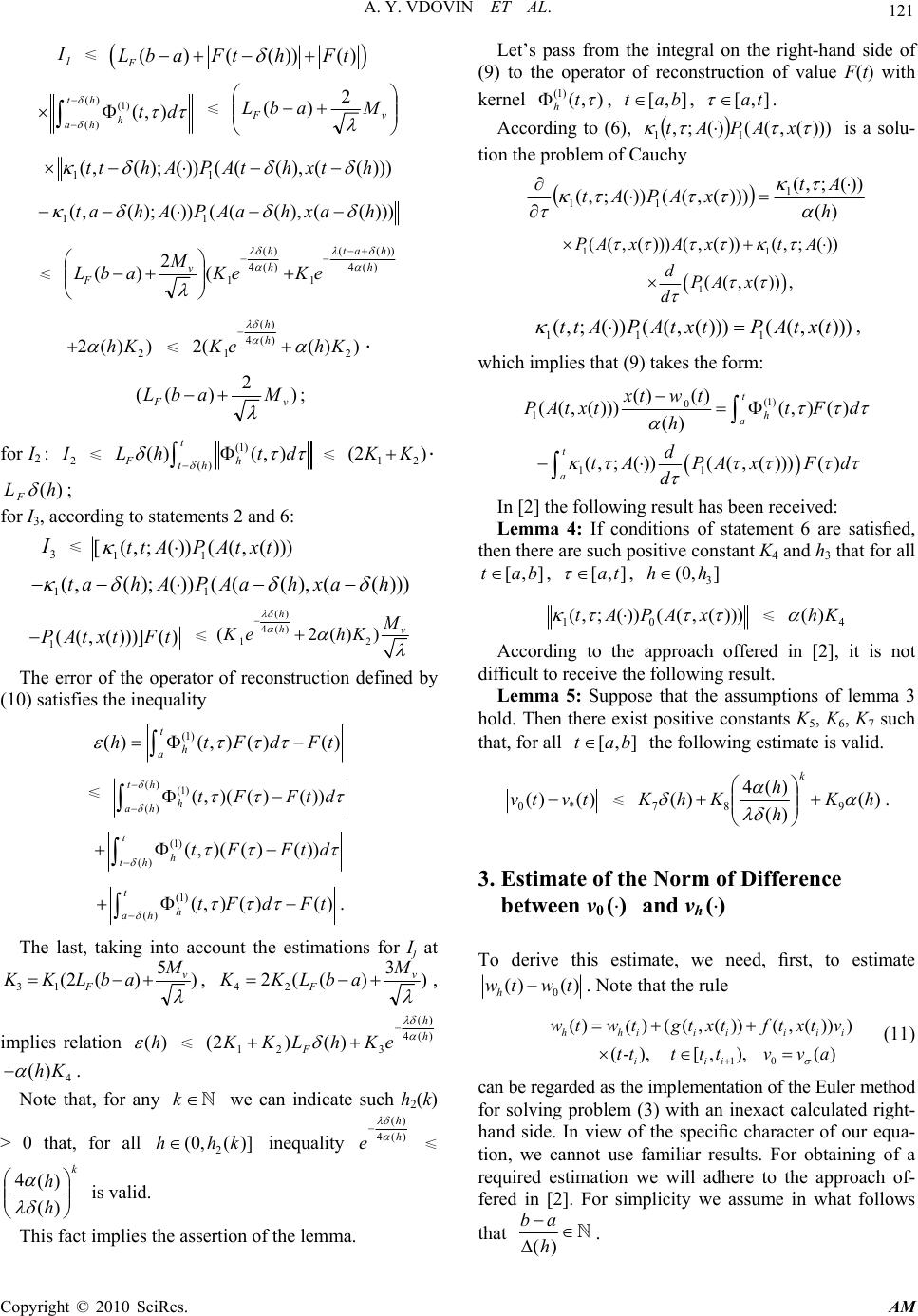 A. Y. VDOVIN ET AL. Copyright © 2010 SciRes. AM 121 1 I ≤ ()(())() F LbaFthFt () (1) () (,) th h ah td ≤ vF MabL 2 )( )))((),((())();(,( 11 htxhtAPAhtt )))((),((())();(,(11 haxhaAPAhat ≤ )(4 ))(( 1 )(4 )( 1 ( 2 )( h hat h h v FeKeK M abL ))(2 2 Kh ≤ ))((2 2 )(4 )( 1KheKh h ) 2 )((vF MabL ; for I2 : 2 I ≤ (1) () () (,) t Fh th Lh td ≤ )2( 21 KK )( hLF ; for I3, according to statements 2 and 6: 3 I ≤ 11 [(,;())((,()))tt APAtxt 11 (,( );())(((),(( )))ta hAPAa hxa h 1(( ,( )))]( ) P At xtFt ≤ () 4() 12 (2()) h hv M Ke hK The error of the operator of reconstruction defined by (10) satisfies the inequality (1) ()(,)()() t h a htFdFt ≤ () (1) () (,)(( )()) th h ah tFFtd (1) () (,)(()()) t h th tF Ftd (1) () (,)( )() t h ah tFdFt . The last, taking into account the estimations for Ij at ) 5 )(2( 13 v F M abLKK , ) 3 )((2 24 v F M abLKK , implies relation )( h ≤ )(4 )( 321 )()2( h h FeKhLKK 4 )( Kh . Note that, for any k we can indicate such h2(k) > 0 that, for all )](,0( 2khh inequality )(4 )( h h e ≤ k h h )( )( 4 is valid. This fact implies the assertion of the lemma. Let’s pass from the integral on the right-hand side of (9) to the operator of reconstruction of value F(t) with kernel ),( )1( t h , ],[ bat , ],[ ta . According to (6), )))(,(()(;, 11 xAPAt is a solu- tion the problem of Cauchy )( ))(;,( )))(,(())(;,( 1 11 h At xAPAt 11 1 ((,()))(,())(,; ()) ((,()), P AxAxt A dPA x d 11 1 ( ,;())((,( )))((,( )))tt APAtxtPAtxt , which implies that (9) takes the form: (1) 0 1 11 () () ((,())) (,)() () (,;())((,()))() t h a t a xtw t PAtxtt Fd h d tAPAx Fd d In [2] the following result has been received: Lemma 4: If conditions of statement 6 are satisfied, then there are such positive constant K4 and h3 that for all ],[ bat , ],[ ta , ],0(3 hh )))(,(())(;,( 01 xAPAt ≤ 4 )( Kh According to the approach offered in [2], it is not difficult to receive the following result. Lemma 5: Suppose that the assumptions of lemma 3 hold. Then there exist positive constants K5, K6, K7 such that, for all ],[ bat the following estimate is valid. )()( *0 tvtv ≤ )( )( )(4 )( 987hK h h KhK k . 3. Estimate of the Norm of Difference between v0)( and vh)( To derive this estimate, we need, first, to estimate )()( 0twtwh. Note that the rule 10 ())((,())( ,())) ( (-), [,), () hhi iiiii iii w tw tgtxtftxtv tttt tvva (11) can be regarded as the implementation of the Euler method for solving problem (3) with an inexact calculated right- hand side. In view of the specific character of our equa- tion, we cannot use familiar results. For obtaining of a required estimation we will adhere to the approach of- fered in [2]. For simplicity we assume in what follows that ba h . 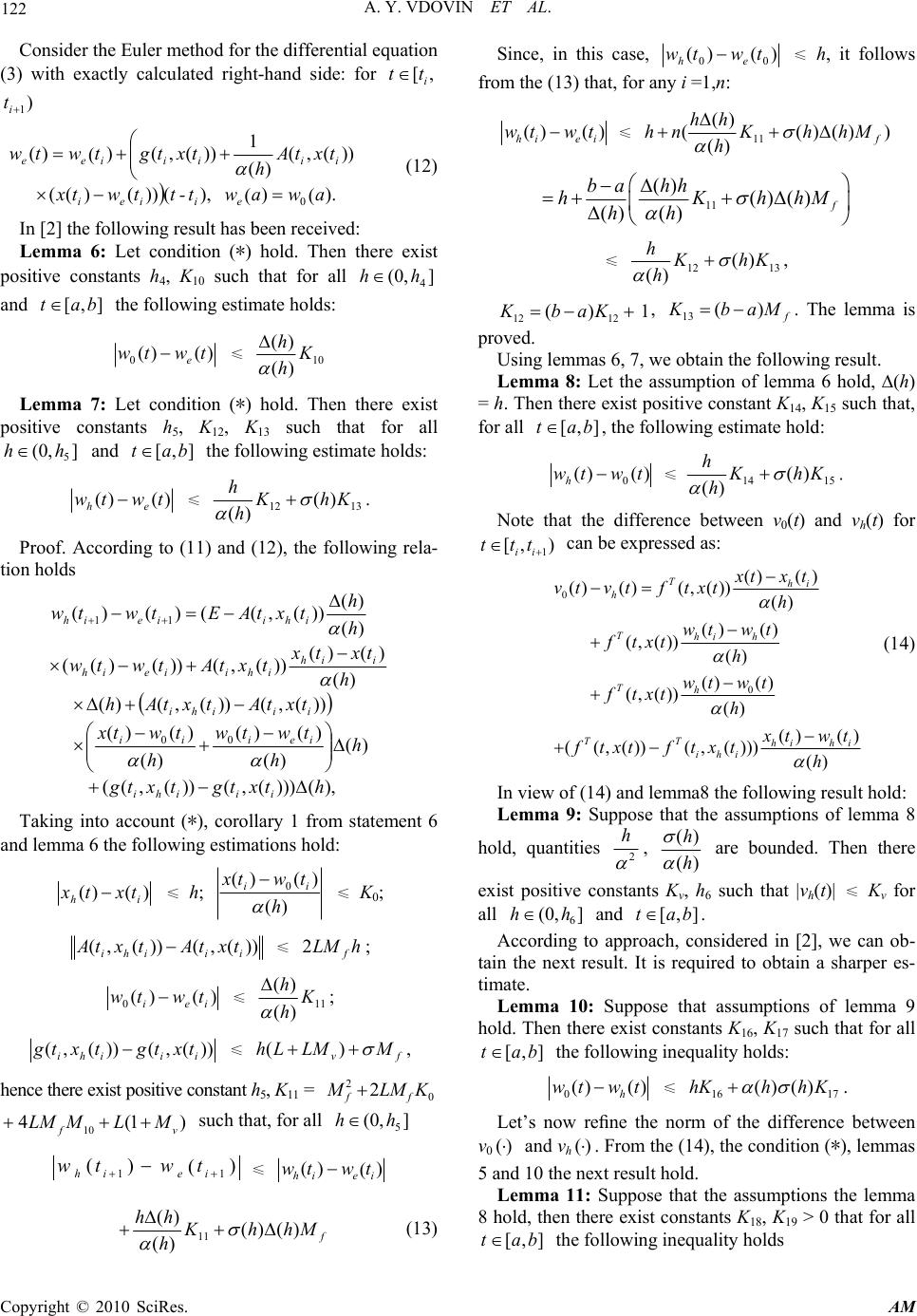 A. Y. VDOVIN ET AL. Copyright © 2010 SciRes. AM 122 Consider the Euler method for the differential equation (3) with exactly calculated right-hand side: for ,[ i tt ) 1i t ). ( ) ( ),())()(( ))(,( )( 1 ))(,() ( )( 0awaw t-ttwtx txtA h txtgtwtw eiiei iiiiiee (12) In [2] the following result has been received: Lemma 6: Let condition (∗) hold. Then there exist positive constants h4, K10 such that for all ],0(4 hh and ],[ bat the following estimate holds: )()( 0twtw e ≤ 10 )( )( K h h Lemma 7: Let condition (∗) hold. Then there exist positive constants h5, K12, K13 such that for all ],0(5 hh and ],[ bat the following estimate holds: )()(twtw eh ≤ 1312 )( )( KhK h h . Proof. According to (11) and (12), the following rela- tion holds ),()))(,())(,(( )( )( )()( )( )()( ))(,())(,()( )( )()( ))(,())()(( )( )( ))(,(()()( 00 11 htxtgtxtg h h twtw h twtx txtAtxtAh h txtx txtAtwtw h h txtAEtwtw iiihi ieiii iiihi iih ihiieih ihiieih Taking into account (∗), corollary 1 from statement 6 and lemma 6 the following estimations hold: )()( ihtxtx ≤ h; )( )()( 0 h twtx ii ≤ K0; ))(,())(,( iiihitxtAtxtA ≤ hLMf 2; )()( 0iei twtw ≤ 11 )( )( K h h ; ))(,())(,( iiihi txtgtxtg ≤ fvMLMLh )( , hence there exist positive constant h5, K11 = 0 22KLMM ff 10 4(1) fv LM MLM such that, for all ],0(5 hh ) ( )( 11 ieih twtw ≤ ) ( )( ieih twtw f MhhK h hh )()( )( )( 11 (13) Since, in this case, )()( 00twtw eh ≤ h, it follows from the (13) that, for any i =1,n: ) ( )( ieihtwtw ≤ ))()( )( )( (11 f MhhK h hh nh 11 () () () () () f ba hh hKhhM hh ≤ 1312 )( )( KhK h h , 12 12 () 1KbaK , f MabK )( 13 . The lemma is proved. Using lemmas 6, 7, we obtain the following result. Lemma 8: Let the assumption of lemma 6 hold, ∆(h) = h. Then there exist positive constant K14, K15 such that, for all ],[ bat , the following estimate hold: )()( 0twtwh ≤ 1514 )( )( KhK h h . Note that the difference between v0(t) and vh(t) for 1 [, ) ii ttt can be expressed as: 0 0 ()() ()()(, ())() () () (,())() () () (,())() () () (( ,( ))(,()))() Thi h Thi h Th TT hi hi ihi x txt vtvtf txth wt wt ftxt h wt wt ftxt h x twt ftxt ftxth (14) In view of (14) and lemma8 the following result hold: Lemma 9: Suppose that the assumptions of lemma 8 hold, quantities 2 h, )( )( h h are bounded. Then there exist positive constants Kv, h6 such that |vh(t)| ≤ Kv for all ],0( 6 hh and ],[ bat . According to approach, considered in [2], we can ob- tain the next result. It is required to obtain a sharper es- timate. Lemma 10: Suppose that assumptions of lemma 9 hold. Then there exist constants K16, K17 such that for all ],[ bat the following inequality holds: )()( 0twtw h ≤ 1716 )()( KhhhK . Let’s now refine the norm of the difference between v0)( and vh)( . From the (14), the condition (∗), lemmas 5 and 10 the next result hold. Lemma 11: Suppose that the assumptions the lemma 8 hold, then there exist constants K18, K19 > 0 that for all ],[ bat the following inequality holds 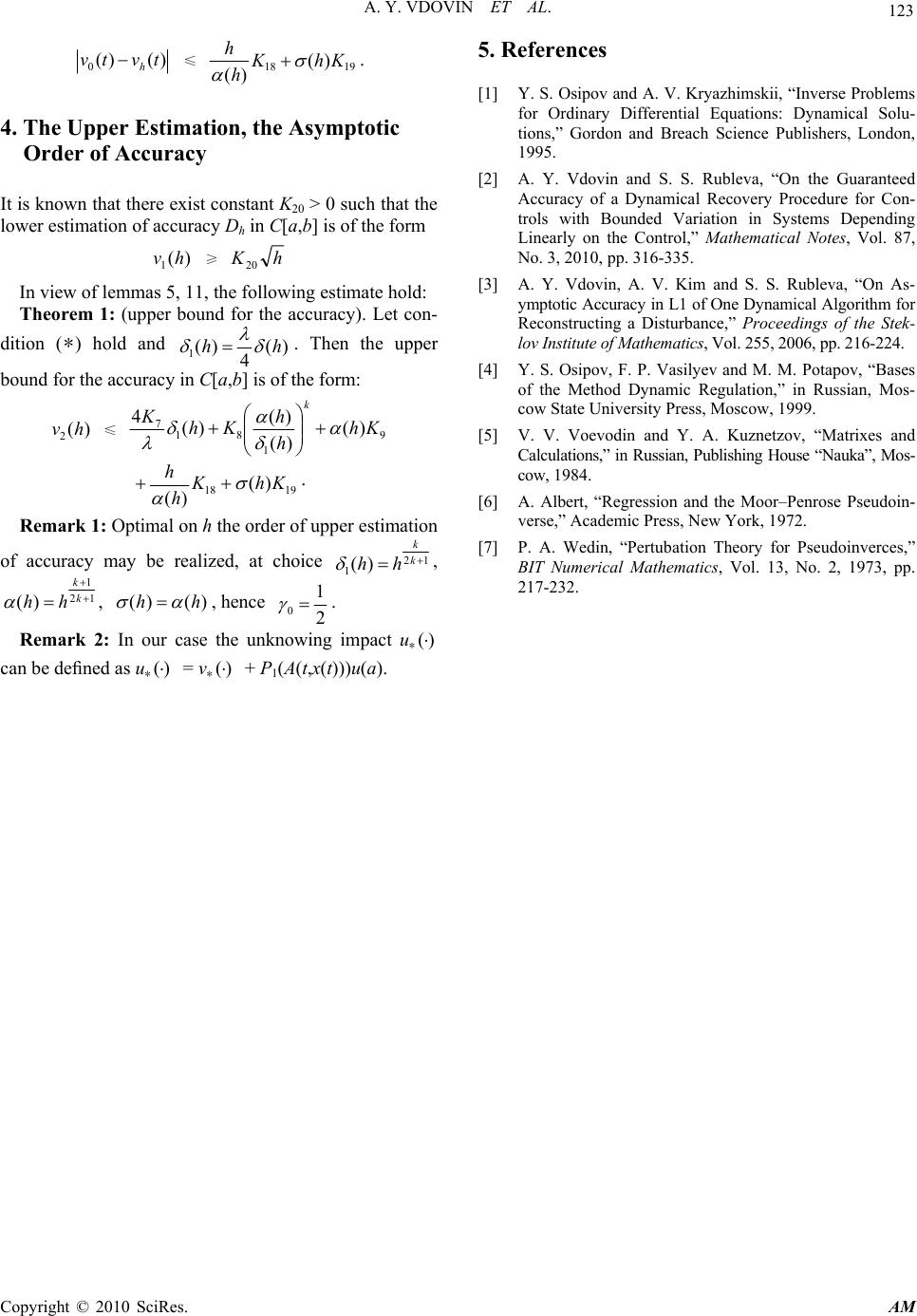 A. Y. VDOVIN ET AL. Copyright © 2010 SciRes. AM 123 )()( 0tvtvh ≤ 1918 )( )( KhK h h . 4. The Upper Estimation, the Asymptotic Order of Accuracy It is known that there exist constant K20 > 0 such that the lower estimation of accuracy Dh in C[a,b] is of the form )( 1hv ≥ hK20 In view of lemmas 5, 11, the following estimate hold: Theorem 1: (upper bound for the accuracy). Let con- dition (∗) hold and )( 4 )( 1hh . Then the upper bound for the accuracy in C[a,b] is of the form: )( 2hv ≤ 9 1 81 7)( )( )( )( 4Kh h h Kh Kk 1918 )( )( KhK h h . Remark 1: Optimal on h the order of upper estimation of accuracy may be realized, at choice 12 1)( k k hh , 12 1 )( k k hh , )()( hh , hence 2 1 0 . Remark 2: In our case the unknowing impact u∗)( can be defined as u∗)( = v∗)( + P1(A(t,x(t)))u(a). 5. References [1] Y. S. Osipov and A. V. Kryazhimskii, “Inverse Problems for Ordinary Differential Equations: Dynamical Solu- tions,” Gordon and Breach Science Publishers, London, 1995. [2] A. Y. Vdovin and S. S. Rubleva, “On the Guaranteed Accuracy of a Dynamical Recovery Procedure for Con- trols with Bounded Variation in Systems Depending Linearly on the Control,” Mathematical Notes, Vol. 87, No. 3, 2010, pp. 316-335. [3] A. Y. Vdovin, A. V. Kim and S. S. Rubleva, “On As- ymptotic Accuracy in L1 of One Dynamical Algorithm for Reconstructing a Disturbance,” Proceedings of the Stek- lov Institute of Mathematics, Vol. 255, 2006, pp. 216-224. [4] Y. S. Osipov, F. P. Vasilyev and M. M. Potapov, “Bases of the Method Dynamic Regulation,” in Russian, Mos- cow State University Press, Moscow, 1999. [5] V. V. Voevodin and Y. A. Kuznetzov, “Matrixes and Calculations,” in Russian, Publishing House “Nauka”, Mos- cow, 1984. [6] A. Albert, “Regression and the Moor–Penrose Pseudoin- verse,” Academic Press, New York, 1972. [7] P. A. Wedin, “Pertubation Theory for Pseudoinverces,” BIT Numerical Mathematics, Vol. 13, No. 2, 1973, pp. 217-232. |

